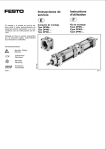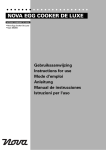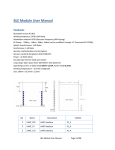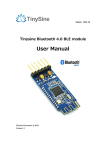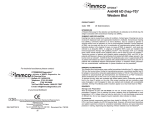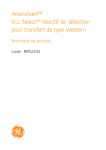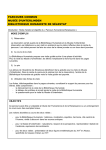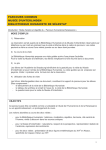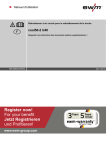Download ImmuBlot™ Anti-P0 Antibody Western Blot
Transcript
ImmuBlot™ Anti-P0 Antibody Western Blot Product Code: 1192 18 Determinations INTENDED USE A Western Blot immunoassay for use in the detection and identification of antibodies to P0, a 30kD antigen associated with autoimmune hearing loss. SUMMARY AND EXPLANATION Hearing loss may be caused by a number of conditions. Certain types of hearing loss can be reversed if diagnosed early and appropriate treatment is instituted. Sensorineural hearing loss (SNHL), commonly referred to as nerve deafness, may be caused by genetic or acquired factors such as infections or can be immunologically mediated. Correct diagnosis of SNHL can be made with the aid of a combination of comprehensive patient history and laboratory studies. In the majority of cases, no cause of SNHL is apparent: such cases are referred to as idiopathic SNHL. Subgroups of idiopathic SNHL cases are treatable with immunosuppressive therapy with gratifying results1, 2. The laboratory work up to identify these cases may include serum antibody tests to 68 KD (hsp-70) inner ear antigen3-8 and other auto antigens such as to P0, a 30 KD antigen7-9. Approximately 60% of patients with progressive SNHL have antibodies to P0. A strong positive correlation between chronic progressive hearing loss and the presence of anti-P0 antibodies was observed. In addition patients with positive P0 antibodies had bilateral hearing loss. PRINCIPLE OF PROCEDURE This Western Blot immunoassay uses purified P0 antigen from the bovine or primate tissue. To perform the test, PVDFstrips are incubated with diluted patient serum. Antibodies specifically bind to the P0 protein on the strip. After proper washing and incubation steps with the Conjugate, strips are washed and incubated with a precipitable substrate. Anti-P0 antibody positive reactions appear as a blue-violet band at 30kD, sometime this reaction is seen as a doublet. REAGENTS Storage and Preparation Store all reagents at 2-8°C. Do not freeze. Do not use if liquid reagents are turbid or a precipitate is present. Prior to starting the assay, reagents must be equilibrated to room temperature (~22°). Antigen strips can only be used once. Do not interchange components of different lots. Do not use reagents beyond expiration date indicated on labels. Precautions All human derived components used have been tested for HBsAg, HCV, HIV-1 and 2 and HTLV-I and found negative by US FDA required tests. However, all human blood derivatives and patient specimens should be considered potentially infectious and good laboratory 1 practices in storing; dispensing and disposing of these materials must be followed10. WARNING - Sodium azide (NaN ) may react with lead and copper plumbing to form highly 3 explosive metal azides. Upon disposal of liquids, flush with large volumes of water to prevent azide buildup. NaN is toxic if ingested. Report incidents immediately to laboratory 3 director or poison control center. Follow good laboratory practices to minimize microbial and cross contamination of reagents. Materials provided ImmuBlot™ Anti-P0 Antibody 1192 ImmuBlot™ The anti-P0 (30kD) antibody Western Blot kit*, contains sufficient reagents to perform 18 determinations. 1 x 18 1 x 120 µl 1 x 120 µl 1 1 x 240 µl 1 x 60 ml 1 x 25 ml 1 vial Western Blot Strips, with P0 antigen. *Positive Control (red vial cap) *Negative Control (yellow vial cap). Control Card *Conjugate (blue vial cap) *Serum Diluent *Enzyme Substrate (amber bottle) Powdered Wash Buffer; reconstitute to one liter with deionized or distilled water. 3 Assay trays *Contains <0.1% NaN Materials Required But Not Provided • Clean 1000 ml graduated cylinder • Non-serrated forceps (Filter forceps) • Rocker or rotating platform shaker • Absorbent paper or paper towels • Deionized or distilled water • Squeeze bottle to hold diluted wash buffer • Pipettes capable of delivering 10 to 1000 µl • Disposable pipette tips • Timer SPECIMEN COLLECTION AND HANDLING Only serum specimens should be used in this procedure. Grossly hemolyzed, lipemic or microbial contaminated specimens may interfere with the performance of the test and should not be used. Store specimens at 2-8°C for no longer than one week. For longer storage, serum specimens should be frozen. Avoid repeated freezing and thawing of samples. 2 PROCEDURE Procedural Notes • Read Product Insert carefully before starting with the assay. • Let serum specimens and test reagents equilibrate to room temperature for ~30 minutes prior to starting the test procedure. Return all unused specimens and reagents to the refrigerator promptly after use. • Proper washing technique is critical to the satisfactory performance of the assay. • Manipulate test strips with clean forceps only. Do not touch with bare hands. • Strips are individually numbered at the top of each strip. Assign specimen identification numbers to the respective strips on the Report Form. • Complete all other relevant information on the Report Form prior to starting the assay. Test Method Step 1 Using blunt forceps, place required number of Strips labeled side up into individual wells of the assay tray. Step 2 Pipette 1.0 ml of Serum Diluent into each well. Step 3 Pipette 20 µl of Positive and Negative Control and patient sample into appropriate wells to obtain a 1:51 dilution. Incubate 90 minutes (±5 min.) at room temperature on a rocker or rotating shaker. Step 4 Aspirate sample solution into waste container. Thoroughly wash strips with Wash Buffer by squirting approximately 2ml of solution directly onto strips. Wash strips with gentle agitation for 5 minutes and aspirate solution into waste container. Repeat 2x. Caution: Complete washing of the strips between incubations is crucial to obtain valid results. Improper washing will result in high background staining. Step 5 Pipette 1.0 ml of Serum Diluent followed by 10 µl of Conjugate into each well. Incubate 1 hour (±5 min) at room temperature on rocker or rotating shaker. Step 6 Repeat Step 4. Step 7 Pipette 1.0 ml Substrate into each well and incubate with gentle shaking 5 minutes (±5 min) at room temperature and reduced light. Step 8 Aspirate liquid in wells into waste container. Thoroughly wash strips with deionized water by squirting approximately 2ml of solution directly onto strips. Wash strips with gentle agitation for 5 minutes aspirate liquid into waste container. Repeat. Step 9 Using blunt forceps, remove strips from assay tray and place them gently onto absorbent paper. Handle strips only at the ends and let them dry 15-20 minutes. Quality Control Though the control cards are lot specific, negative and positive controls must be included in each test run to ensure proper performance of the assay. Positive Control Reaction: The positive control strip will exhibit a dense blue-violet band at 30kD, sometimes a doublet (Figure 1). Negative Control Reaction: Typically, the negative control will exhibit no band. Sometimes some sera may give reactions on the strip but not at 30kD. 3 MW marker 30 kD (anti-P0) Figure 1: Diagram of PO Positive Reaction RESULTS Reading and Interpretation Guidelines Step 1 Hold test strip between the positive and negative control reactions on the provided, laminated Control Card and align test strip using the alignment marker as the reference point. Step 2 Compare reaction of test strip with those of the controls on either side. Use of a magnifying glass can facilitate proper alignment of test strips along the molecular weight marker and assist in observation of weak reactions. Step 3 Check for a band on the test strip that aligns with the 30kD band on the positive control strip. Such a reaction should be considered positive. Positive reactions can occur in varying intensities from weak to strong. Weak reactions should be compared with baseline reaction intensities at the corresponding position on the negative control strip. Reactions that are distinctly darker or denser than the baseline intensity should be considered positive. Occasionally, minor bands may be visible with certain sera. However, such reactions are not relevant and should be considered as negative for antibodies to P0 (30kD) antigen. Note: Automated Western blot machines can occasionally show extra bands that may not be related to the 30kD band. Ensure the washing cycle is thorough. Repeat process manually for clarity. Antibodies to P0 (30kD) antigen occur in patients with autoimmune hearing loss. Anti-P0 (30kD) Antibodies in Patients with SNHL8 Disease Group No. Tested No. Positive % Positive Sudden Progressive Unspecified Normal 9 20 5 90 1 14 2 1 11 60 40 1 LIMITATIONS OF THE PROCEDURE The Immublot™ anti-P0 (30kD) antibody Western Blot assay should be used as an aid to the diagnosis of autoimmune hearing loss. Positive results may be found in other autoimmune conditions such as in peripheral neuropathy. Hence results should be evaluated and interpreted by a medical authority in light of the patient’s clinical history and other laboratory findings. Some sera may react to antigens of other molecular sizes. These are not of any clinical relevance. 4 TROUBLESHOOTING GUIDE • • • • Strong band at 30kD on Negative Control strip. Likely cause: contaminated Negative Control vial or cross contamination from well containing a positive serum. Positive Control appears like Negative Control strip. Likely cause: Negative Control vial was confused as Positive Control vial. Strips are completely blank. Likely cause: addition of Conjugate or Substrate was omitted. High background and poor contrast between bands and background. Likely cause: wash step (s) may have been omitted or incorrectly performed, or incubations were overextended. REFERENCES 1. McCabe BF, Autoimmune sensorinerual hearing loss. Ann Otol. 1979; 88:5852-589. 2. Arnold W, Pfaltz R, Alternalt HJ. Evidence of serum antibodies against inner ear tissues in the blood of patients with certain sensorineural hearing disorders. Acta Otolaryngol (Stockh). 1985; 99:437-444. 3. Harris JP, Sharp PA. Inner ear autoantibodies in patients with rapidly progressive sensorinerual hearing loss. Laryngoscope. 1990; 100:516-524. 4. Yamanobe S, Harris JP. Inner ear-specific autoantibodies. Laryngoscope. 1993; 103:319325. 5. Shin S, Billings P, Keithley EM, Harris JP. Comparison of anti-heat shock protein 70 (antishp-70) and anti-68-kD inner ear protein in the sera of patients with meniere’s disease. Laryngoscope. 1997; 107:222-227. 6. Harris JP and Aframian D. Role of autoimmunity in contralateral delayed endolymphatic hydrops. Am J Otol. 1994; 15:710-716. 7. Yoo TJ, Du X, Kwon SS. Molecular mechanism of autoimmune hearing loss. Acta Otolaryngol Suppl. 2002;548:3-9. Review. 8. Tomasi JP, Lona A, Deggouj N, Gersdorff M. Autoimmune sensorineural hearing loss in young patients: an exploratory study. Laryngoscope. 2001;11:2050-3. 9. Boulassel MR, Deggouj N, Tomasi JP, Gersdorff M. Inner ear autoantibodies and their targets in patients with autoimmune inner ear diseases. Acta Otolaryngol. 2001;121:28-34. 10. Biosafety in Microbiological and Biomedical Laboratories. Centers for Disease Control, National Institutes of Health, 1993 [HHS Pub. No. (CDC) 93-8395]. 5 ImmuBlot™ Anti-P0 Antibody Western Blot Code: 1192 18 déterminations UTILISATION PRÉVUE Une analyse de Western Blot pour la détection et l’identification des anticorps à l’antigène de P0, une 30kD antigène s’est associée à la perte d’audition neuro-sensorielle (SNHL). SOMMAIRE ET EXPLICATION La perte d’audition peut être provoquée par un certain nombre de conditions. Certains types de perte d’audition peuvent être renversés si le traitement tôt et approprié diagnostiqué est institué. La perte d’audition neuro-sensorielle (SNHL), généralement désignée sous le nom de la surdité de nerf, peut être provoquée par des facteurs génétiques ou acquis tels que des infections ou peut être immunologiquement négociée. Le diagnostic correct de SNHL peut être fait à l’aide d’une combinaison des études patientes complètes d’histoire et de laboratoire. Dans la majorité de cas, aucune cause de SNHL n’est évidente : de tels cas désigné sous le nom de SNHL idiopathique. Un sous-groupe de cas idiopathiques de SNHL sont traitable avec la thérapie immunosuppressive avec les résultats agréables 1,2. Le travail de laboratoire identifient jusqu’à ces caisses peut inclure des essais d’anticorps de sérum à la 68 kD antigène (hsp-70) 3-8 et à d’autres autoantigènes comme à P0, une 30 kD antigene 7-9. Approximativement 60% de patients avec SNHL progressif ont des anticorps à P0. On a observé une corrélation positive forte entre la perte d’audition progressive chronique et la présence des anticorps anti-P0. En outre les patients avec des anticorps P0 positifs ont eu la perte d’audition bilatérale. PRINCIPE DE PROCÉDÉ Cette analyse de Western Blot emploie l’antigène P0 purifié du tissu de bovin ou de primat. Pour réaliser l’essai, des bandelettes de PVDF sont incubées avec le sérum patient dilué. Les anticorps lient spécifiquement à la protéine P0 sur la bandelette. Après des étapes appropriées de lavage et d’incubation avec le conjugué, des bandelettes sont lavées et incubées avec un substrat. Les réactions positives apparaissent car une marque bleuviolette à sa réaction de 30kD. La réaction peut apparaître comme doublet. RÉACTIFS Stockage et Preparation Stockez tous les réactifs à 2-8° C. Ne gelez pas. N’employez pas, si les réactifs liquides sont troubles ou un précipité est présent. Avant de commencer l’analyse, des réactifs doivent être équilibrés à la température ambiante (~22°). Des bandes d’antigène peuvent seulement être employées une fois. N’échangez pas les composants de différents sorts. N’employez pas les réactifs au delà de la date d’échéance indiquée sur des étiquettes. Précautions Tous les composants dérivés humains utilisés ont été examinés pour HBsAg, HCV, Hiv-1 et 2 et Htlv-I et négatif trouvé par les essais exigés par FDA des USA. Cependant, tous les dérivés humains de sang et spécimens patients devraient être considérés potentiellement 6 infectieux et de bonnes pratiques en matière de laboratoire en stockant, en distribuant et en ayant ces matériaux doivent être suivies 10. Attention - l’azoture de sodium (NaN3) peut réagir avec le fil et la tuyauterie de cuivre aux azotures fortement explosifs en métal de forme. Sur la disposition des liquides, éclat avec de grands volumes de l’eau pour empêcher l’habillage d’azoture. NaN 3 est toxique s’ingéré. Rapportez les incidents immédiatement au centre de commande de directeur ou de poison de laboratoire. Suivez les bonnes pratiques en matière de laboratoire de réduire au minimum la contamination microbienne et en travers des réactifs. Matériaux fournis Code : 1192 Le kit contient les réactifs suffisants pour effectuer 18 déterminations. 1 x 18 bandelettes Western Blot 1 x 120 µl *contrôle positif, prêt à l’emploi 1 x 120 µl *contrôle négatif, prêt à l’emploi 1 carte de contrôe 1 x 240 µl *conjugué 1 x 60 ml *diluant pour échantillons 1 x 25 ml *substrat enzymatique 1 tampon de lavage pour 1 litre/flacon 3 bains d’analyse * Contient < 0.1% NaN 3 Matériaux Requis Mais Non fournis • Nettoyez le cylindre reçu un diplôme 1000 par ml • forceps non-dentelé • Culbuteur ou dispositif trembleur tournant de plateforme • Papier absorbant ou serviettes de papier • Désionisé ou eau distillée • Bouteille de compression à l’amortisseur de lavage dilué par prise • Pipettes capables de fournir 10 à 1000 µl • Jetable introduisez à la pipette les bouts • Temporisateur COLLECTION ET MANIPULATION DE SPÉCIMEN Seulement des spécimens de sérum devraient être employés dans ce procédé. Hémolysés excessivement, les spécimens lipémiques ou par microbes souillés peuvent interférer l’exécution de l’essai et ne devraient pas être employés. Stockez les spécimens à 2-8° C pour plus qu’une semaine. Pour un entreposage plus prolongé, des spécimens de sérum devraient être gelés. Évitez la congélation et le dégel répétés des échantillons. Méthode Notes Procédurales • Lisez les instructions soigneusement avant commençant par l’analyse. • Laissez les spécimens de sérum et les réactifs d’essai équilibrer à la température ambiante pendant les minutes ~30 avant de commencer la méthode d’essai. Renvoyez tous les spécimens et réactifs inutilisés au après utilisation de réfrigérateur promptement. • La technique de lavage appropriée est critique à l’exécution satisfaisante de l’analyse. • Manoeuvrez les bandes d’essai avec les forceps propres seulement. Ne touchez pas avec les mains nues. • Des bandes sont individuellement numérotées au dessus de chaque bande. Assignez les numéros d’identification de spécimen aux bandes respectives sur le rapport. • Remplissez toute autre information appropriée sur le rapport avant de commencer l’analyse. 7 Examinez La Méthode 1. En utilisant le forceps émoussé, placez le nombre requis de côté marqué par les bandelettes Western Blot vers le haut dans différents puits du plateau d’analyse. 2. Introduisez à la pipette 1.0 ml du diluant pour échantillons dans chacun bien. 3. Introduisez à la pipette 20 µl du contrôles positif et negatif et échantillon patient dans les puits appropriés pour obtenir une dilution de 1:51. Incubez 90 minutes (± 5 minutes.) à la température ambiante sur un culbuteur ou un dispositif trembleur tournant. 4. Aspirez la solution témoin dans le bac à vidange. Lavez complètement les bandes avec le tampon de lavage en injectant approximativement 2ml de solution directement sur des bandes. Lavez les bandes avec l’agitation douce pendant 5 minutes et aspirez la solution dans le bac à vidange. Répétez 2x. Attention : Le lavage complet des bandes entre les incubations est crucial d’obtenir des résultats valides. Le lavage inexact aura comme conséquence le fond élevé souillant. 5. Introduisez à la pipette 1.0 ml diluant pour échantillons suivi 10 µl de Conjugué dans chacun bien. Incubez 60 minutes (± 5 minutes) à la température ambiante sur le culbuteur ou le dispositif trembleur tournant. 6. Répétez L’Étape 4. 7. Introduisez à la pipette 1.0 ml substrat dans chacun puits et incubez avec doux en secouant 5 minutes (± 5 minutes) à la température ambiante et à la lumière réduite. 8. Aspirez le liquide dans les puits dans le bac à vidange. Lavez complètement les bandes avec de l’eau désionisé en injectant approximativement 2ml de solution directement sur des bandes. Les bandes de lavage avec l’agitation douce pendant 5 minutes aspirent le liquide dans le bac à vidange. Répétez. 9. En utilisant le forceps émoussé, enlevez les bandes du plateau d’analyse et placezles doucement sur le papier absorbant. Manipulez les bandes seulement aux extrémités et laissez-les sécher 15-20 minutes. Contrôle de qualité Bien que les cartes de commande soient détail de sort, des commandes négatives et positives doivent être incluses dans chaque essai pour assurer l’exécution appropriée de l’analyse. Réaction de contrôle positive: La bande positive montrera une bande bleu-violette dense à 30kD. Ceci peut être un doublet (le schéma 1). Réaction de contrôle négative: Typiquement, la contrôle négative ne montrera aucune bande. Les sérums peuvent donner des réactions sur la bande mais pas à 30kD. Le schéma 1: Diagramme de la réaction positive de PO MW Marker – Marqueur de Poids Moléculaire INTERPRÉTATION DES RÉSULTATS 1. Tenez la bande d’essai entre les réactions de contrôles positives et négatives sur la carte de contrôle fourni et et alignez la bande d’essai en utilisant le marqueur d’alignement comme point de référence. 2. Comparez la réaction de la bande d’essai à ceux des commandes de chaque côté. L’utilisation d’une loupe peut faciliter l’alignement approprié des bandes d’essai le long du marqueur de poids moléculaire et aider à l’observation des réactions faibles. 3. Vérifiez une bande croquante sur la bande d’essai qui aligne avec la bande positive de contrôle. Une telle réaction devrait être considérée positive. Les réactions positives peuvent se produire dans des intensités variables de faible à fort. Des 8 réactions faibles devraient être comparées aux intensités de réaction de ligne de base à la position correspondante sur la bande négative de contrôle. Des réactions qui sont distinctement plus foncées ou plus denses que l’intensité de ligne de base à 30kD devraient être considérées positives. De temps en temps, le poids moléculaire inférieur mineur bandes peut soit évident avec certains sérums. Cependant, de telles réactions ne sont pas appropriées et devraient être considérées en tant que négatif pour des anticorps à l’antigène P0 (30kD). Note : Les machines automatisées de tache de Western peuvent montrer les bandes supplémentaires qui ne peuvent être liées à la bande 30kD. Assurez le cycle de lavage est complet. Répétez le processus manuellement pour la clarté. Les anticorps à l’antigène P0 (30kD) se produisent dans les patients présentant la perte d’audition autoimmune. Anticorps anti-P0 (30kD) dans les patients avec SNHL Groupe Soudain Progressif Non spécifié Normale Numéro Examiné Numéro Positif 9 20 5 90 1 14 2 1 8 % Positif 11 60 40 1 LIMITATIONS DU PROCÉDÉ Le P0 Western Blot (30kD) kit devrait être employée comme aide au diagnostic. Des résultats positifs peuvent être trouvés en d’autres conditions autoimmunes ou certaines maladies infectieuses. Par conséquent des résultats devraient être évalués et interprétés par une autorité médicale à la lumière de l’histoire clinique du patient et d’autres résultats de laboratoire. Quelques sérums peuvent réagir au marqueur de MW de temps en temps, dont la signification n’est pas connue. GUIDE DE DÉPANNAGE • Bande forte à 30kD sur la bande de Contrôle Negative. Cause probable : fiole souillée de Contrôle Negative, ou contamination en travers à partir du puits contenant un sérum positif. • Contrôle Positif apparaît comme la bande de Contrôle Negative. Cause probable : La fiole Contrôle Négative a été confondue comme fiole de Contrôle Positif. • Les bandes sont complètement blanches. Cause probable : addition de Conjugué ou Substrat ont été omis. • Contraste de fond élevé et de pauvres entre les bandes et le fond. Cause probable : L’Étape de lavage a pu avoir été omis ou inexactement exécuté, ou des incubations ont été étendues. 9 REFERENCES • REFERENCIAS • LITERATUR • RIFERIMENTI 1. McCabe BF, Autoimmune sensorinerual hearing loss. Ann Otol. 1979; 88:5852589. 2. Arnold W, Pfaltz R, Alternalt HJ. Evidence of serum antibodies against inner ear tissues in the blood of patients with certain sensorineural hearing disorders. Acta Otolaryngol (Stockh). 1985; 99:437-444. 3. Harris JP, Sharp PA. Inner ear autoantibodies in patients with rapidly progressive sensorinerual hearing loss. Laryngoscope. 1990; 100:516-524. 4. Yamanobe S, Harris JP. Inner ear-specific autoantibodies. Laryngoscope. 1993; 103:319-325. 5. Shin S, Billings P, Keithley EM, Harris JP. Comparison of anti-heat shock protein 70 (anti-shp-70) and anti-68-kD inner ear protein in the sera of patients with meniere’s disease. Laryngoscope. 1997; 107:222-227. 6. Harris JP and Aframian D. Role of autoimmunity in contralateral delayed endolymphatic hydrops. Am J Otol. 1994; 15:710-716. 7. Yoo TJ, Du X, Kwon SS. Molecular mechanism of autoimmune hearing loss. Acta Otolaryngol Suppl. 2002;548:3-9. Review. 8. Tomasi JP, Lona A, Deggouj N, Gersdorff M. Autoimmune sensorineural hearing loss in young patients: an exploratory study. Laryngoscope. 2001;11:2050-3. 9. Boulassel MR, Deggouj N, Tomasi JP, Gersdorff M. Inner ear autoantibodies and their targets in patients with autoimmune inner ear diseases. Acta Otolaryngol. 2001;121:28-34. 10. Biosafety in Microbiological and Biomedical Laboratories. Centers for Disease Control, National Institutes of Health, 1993 [HHS Pub. No. (CDC) 938395]. 10 11 For technical assistance please contact: IMMCO Diagnostics, Inc. 60 Pineview Drive Buffalo, NY 14228-2120 Telephone: (716) 691-0091 Fax: (716) 691-0466 Toll Free USA/Canada: 1-800-537-TEST E-Mail: [email protected] or your local product distributor EU Authorized Representative/Autorisierter Repräsentant/Rappresentante Autorrizzato/Representante Autorizado/Représentant Autorisé EMERGO Group, Inc. Molenstraat 15, 2513 BH, The Hague, The Netherlands Tel (+31) 345 8570, Fax (+31) 346 7299 www.emergogroup.com Document No. PI4192 CE EF REV.NOV2004 12













